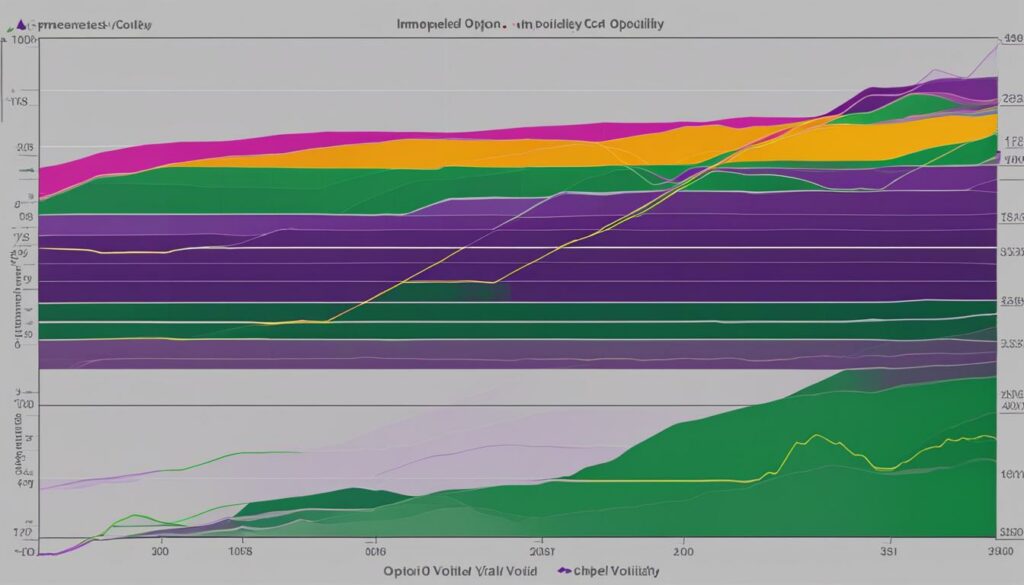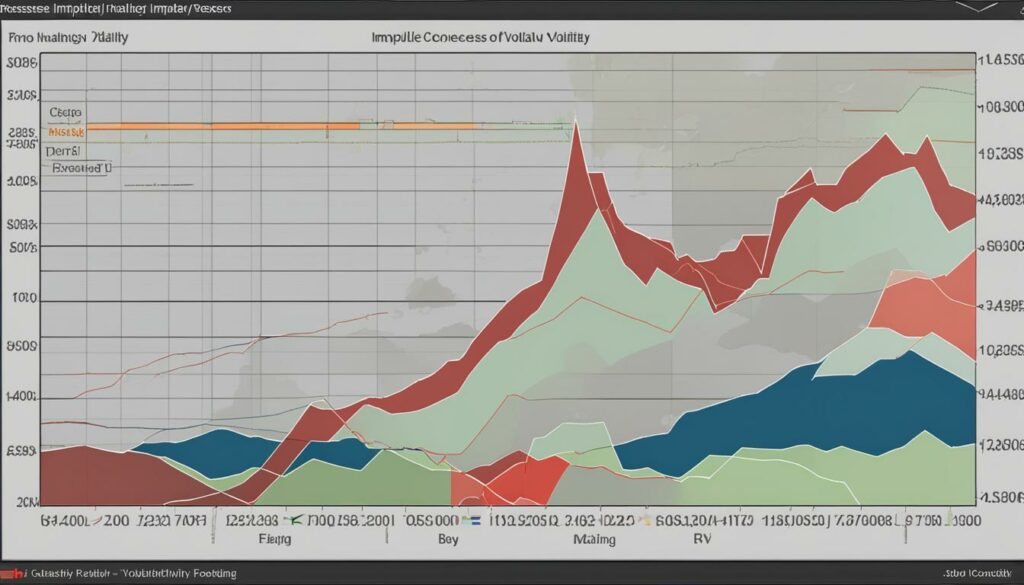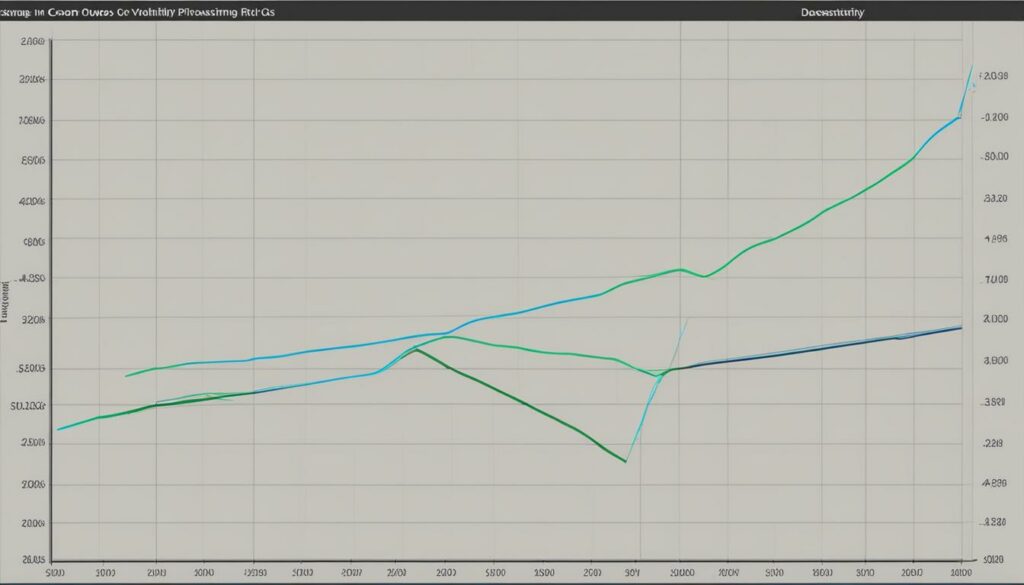Consequences of Decreasing Implied Volatility


Implied volatility plays a crucial role in options trading, impacting option prices and trade outcomes. When implied volatility decreases, it can have significant consequences for investors and traders. Understanding the effects of lowering implied volatility is essential for successful options trading and risk management strategies.
Key Takeaways:
- Decreasing implied volatility can lead to cheaper option prices and reduced time value.
- Investors may face potential losses and changes in the probability of options finishing in the money.
- Analyzing and forecasting implied volatility can help identify undervalued or overvalued options.
- Matching volatility expectations with appropriate option strategies is crucial for successful trading.
- Managing volatility is essential for minimizing risk and maximizing returns in a volatile market.
Basics of Option Pricing and Implied Volatility
Option pricing involves understanding two main components: intrinsic value and time value. Intrinsic value is the equity that an option holds based on the difference between the strike price and the current market price of the underlying asset. On the other hand, time value represents the potential for the option to gain additional value before expiration.
When it comes to option pricing, implied volatility plays a crucial role. Implied volatility reflects the market’s expectation of how volatile the underlying asset will be over the option’s lifespan. It is influenced by factors such as market conditions, supply and demand for options, and market expectations of stock price movement.
Changes in implied volatility can significantly impact option prices. When implied volatility increases, option premiums tend to become more expensive due to the higher expected price swings in the underlying asset. Conversely, when implied volatility decreases, option premiums tend to become cheaper.
Understanding Option Premiums
Option premiums are the prices that investors pay to purchase options. They are calculated by combining the intrinsic value and time value of the option. Intrinsic value represents the immediate equity of the option, while time value represents the potential for the option to gain further value before expiration.
Implied volatility affects the time value component of the option premium. Higher implied volatility results in a higher time value, leading to increased option premiums. Conversely, lower implied volatility results in a lower time value, leading to decreased option premiums.
| Option Premium Components | Implied Volatility |
|---|---|
| Intrinsic Value | Remains the same |
| Time Value | Increases with higher implied volatility |
| Option Premium | Increases with higher implied volatility |
Understanding the impact of implied volatility on option pricing is crucial for investors and traders. By analyzing implied volatility and its potential future changes, traders can make informed decisions and potentially profit from fluctuations in option premiums.


How Implied Volatility Affects Options
Implied volatility is a critical factor that directly impacts options trading. Understanding how it affects options can help investors make informed decisions and manage their risks effectively. Implied volatility is influenced by the supply and demand of options and market expectations of stock price direction.
When there is an increase in implied volatility, it generally leads to higher-priced option premiums, indicating greater market uncertainty. Conversely, a decrease in implied volatility results in cheaper option prices, suggesting reduced market expectations of price fluctuations. Options with higher implied volatility are more sensitive to changes in implied volatility, making them potentially riskier but also offering higher profit potential.
Implied volatility plays a crucial role in determining the cost of time value and the success of options trades. It is important for options traders to monitor changes in implied volatility and adjust their strategies accordingly.
One way to gauge the impact of implied volatility on options prices is by analyzing the volatility skew. The volatility skew refers to the varying implied volatility levels across different strike prices or expiration dates. It provides insights into market sentiment and the demand for options at different price levels. Traders can use the volatility skew to identify potential opportunities and risks in the options market.
| Strike Price | Implied Volatility | Option Price |
|---|---|---|
| 100 | 20% | $2.50 |
| 110 | 15% | $1.80 |
| 120 | 10% | $1.20 |
In the example above, as the strike price increases, the implied volatility decreases, and so does the option price. This demonstrates the inverse relationship between implied volatility and option prices. Traders can use this information to select options that align with their risk tolerance and trading strategies.
How to Navigate Changing Implied Volatility
Managing the impact of changing implied volatility is crucial for options traders. By monitoring market conditions, using volatility forecasting techniques, and adjusting strategies accordingly, traders can potentially profit from volatility changes. It is essential to stay updated on current market trends and to implement risk management strategies to protect against potential losses.
- Stay informed: Keep up with market news, events, and company earnings releases as they can significantly impact implied volatility.
- Use volatility forecasting: Analyze historical implied volatility and market indicators to forecast future changes in implied volatility.
- Adjust strategies: Based on anticipated changes in implied volatility, adapt options strategies to take advantage of potential opportunities or mitigate risks.
By staying informed, utilizing volatility forecasting, and adjusting strategies accordingly, options traders can navigate changing implied volatility and potentially maximize their trading performance.


Utilizing Implied Volatility to Your Advantage
Analyzing implied volatility is an essential aspect of options trading. By understanding the behavior of implied volatility, traders can identify opportunities to buy undervalued options and sell overvalued options. Volatility forecasting techniques can provide insights into future changes in implied volatility, allowing traders to make informed decisions.
When analyzing implied volatility, traders can compare the current level of implied volatility to historical levels. If the current implied volatility is lower than historical levels, it may indicate that options are undervalued. On the other hand, if the current implied volatility is higher than historical levels, it may suggest that options are overvalued.
Buying undervalued options can be a strategy to capitalize on potential increases in implied volatility. When implied volatility rises, option prices tend to increase, resulting in potential profits for traders who hold undervalued options. Conversely, selling overvalued options can be a strategy to benefit from potential decreases in implied volatility. If implied volatility decreases, option prices may decline, allowing traders to profit from selling options at a higher price than their market value.
Example:
“Analyzing implied volatility helped me identify an undervalued option. The stock was experiencing low implied volatility compared to its historical levels, indicating that the option price was relatively cheap. I decided to buy the option and hold it until the implied volatility increased. When the implied volatility spiked, the option price surged, and I was able to sell it for a significant profit.”
In conclusion, analyzing implied volatility can provide valuable insights for options traders. By utilizing volatility forecasting techniques and identifying undervalued or overvalued options, traders can enhance their trading strategies and potentially maximize returns.


Exploring Volatility and Option Strategies
Volatility plays a crucial role in determining the success of option strategies. By understanding how implied volatility impacts option prices, traders can leverage this knowledge to optimize their trading strategies. Let’s dive deeper into the various option strategies that can be implemented based on volatility levels.
Buying Strategies
Low implied volatility presents buying opportunities for options traders. When volatility is low, options tend to be relatively cheaper. Traders can consider buying call options or executing a long straddle strategy to capitalize on potential price movements. The long straddle strategy involves buying both a call option and a put option with the same strike price and expiration date, anticipating significant price swings in either direction.
Selling Strategies
On the other hand, high implied volatility can favor selling strategies. When volatility is high, option premiums tend to be relatively expensive. Traders can employ selling strategies such as covered calls or credit spreads. A covered call involves selling a call option against an underlying stock position, generating income from the premium while potentially capping potential gains. A credit spread strategy involves selling an option at a higher strike price and simultaneously buying an option at a lower strike price, aiming to profit from the difference in premiums.
Table: Comparison of Buying and Selling Strategies Based on Implied Volatility
| Buying Strategies | Selling Strategies | |
|---|---|---|
| Implied Volatility | Low | High |
| Options Strategy | Buying call options Long straddle strategy | Covered calls Credit spreads |
| Objective | Profit from potential price movements | Generate income from premium Profit from time decay |
| Risk/Reward | Potential for unlimited gains Limited risk to premium paid | Limited profit potential Limited risk with defined maximum loss |
Matching the volatility expectations with appropriate option strategies is essential for successful trading. Traders need to carefully evaluate their risk tolerance, market outlook, and the potential rewards of each strategy before executing any trades. Additionally, it is crucial to monitor and adjust strategies as market conditions and implied volatility levels change over time.
Volatility and Option Pricing Models
Option pricing models play a crucial role in determining the value of options, and one of the key components in these models is implied volatility. The most widely used option pricing model is the Black-Scholes model, which takes into account various factors such as strike price, time until expiration, interest rates, and dividends to calculate the fair value of an option. Implied volatility, representing market expectations for the future movement of the underlying asset, is an essential input in this calculation.
Calculating implied volatility involves using option pricing models, such as the Black-Scholes model, in reverse. By inputting the market price of an option and the other factors mentioned earlier, the model can solve for the implied volatility. This implied volatility reflects the market’s collective opinion on the potential future volatility of the underlying stock. Traders and investors can use this information to assess the relative attractiveness of options and make informed decisions.
The Black-Scholes model and other option pricing models provide a structured framework for understanding the relationship between implied volatility and option prices. These models help traders and investors gain insights into how changes in implied volatility can impact option premiums and overall portfolio performance. By analyzing implied volatility within the context of option pricing models, market participants can identify mispriced options and potentially take advantage of market inefficiencies.
Example: Implied Volatility Calculation
Let’s consider a hypothetical example to illustrate the concept of implied volatility calculation using the Black-Scholes model. Suppose we have a call option on a stock with a strike price of $100, a time until expiration of 30 days, a risk-free interest rate of 2%, and no dividends. The market price of this option is $5.
| Input | Value |
|---|---|
| Option Price | $5 |
| Strike Price | $100 |
| Time until Expiration | 30 days |
| Interest Rate | 2% |
| Dividends | None |
Using the Black-Scholes model, we can solve for the implied volatility that would result in a market price of $5 for this option. Let’s assume that the implied volatility calculated is 30%. This implies that market participants expect the underlying stock to have a standard deviation of 30% over the next 30 days. Traders and investors can use this information to assess the attractiveness of this option given their own volatility expectations and risk appetite.
Understanding option pricing models and how they incorporate implied volatility is crucial for pricing and trading options effectively. By studying the relationships between implied volatility, option prices, and other factors, market participants can gain valuable insights into market dynamics and make informed decisions.


The Relationship Between Implied Volatility and Supply-Demand Equilibrium
Implied volatility, a crucial metric in options trading, is not only influenced by market factors but also by the supply and demand dynamics of options contracts. The relationship between implied volatility and supply-demand equilibrium leads to the emergence of volatility skew and volatility smile patterns, which provide valuable insights into market sentiment and expectations.
Volatility skew refers to the uneven distribution of implied volatility across different strike prices or expiration dates. It is often observed that options with lower strike prices tend to have higher implied volatility compared to options with higher strike prices. This skew indicates that market participants are willing to pay a higher premium for out-of-the-money options, reflecting the belief that a significant market move is more likely. On the other hand, options with higher strike prices have lower implied volatility, suggesting a lower probability of a large market move.
“The volatility skew can offer valuable information about market sentiment. Traders can use it to identify potential opportunities for buying or selling options based on their risk appetite and market expectations.” – Options Trading Expert
In contrast, a volatility smile pattern is characterized by relatively higher implied volatility for both out-of-the-money and in-the-money options, with the lowest implied volatility observed at the at-the-money strike price. This pattern suggests that market participants anticipate greater price swings in the underlying asset, regardless of the direction. The volatility smile is often associated with market events or news that could generate substantial uncertainty and volatility.
Understanding the relationship between implied volatility and supply-demand equilibrium is vital for traders seeking to make informed decisions in options trading. By analyzing volatility skew and volatility smile patterns, market participants can better assess option pricing and market dynamics. This knowledge can help traders select appropriate options strategies and manage their risk effectively.
| Key Takeaways: |
|---|
| Implied volatility is influenced by supply and demand dynamics in the options market. |
| The volatility skew shows the uneven distribution of implied volatility across different strike prices, indicating market sentiment and expectations. |
| The volatility smile pattern reflects higher implied volatility for out-of-the-money and in-the-money options, suggesting increased market uncertainty. |
| Understanding these patterns can assist traders in selecting appropriate options strategies and managing risk. |
Conclusion
Managing volatility is a crucial aspect of options trading and risk management. The consequences of decreasing implied volatility can impact option prices, probability of success, and overall portfolio performance. Therefore, understanding how implied volatility affects option premiums and utilizing volatility management strategies is essential.
By employing volatility forecasting techniques and analyzing historical implied volatility, traders can identify undervalued and overvalued options. Buying undervalued options and selling overvalued options can be effective strategies to capitalize on changes in implied volatility. This approach allows traders to potentially maximize returns by taking advantage of mispriced options.
Implementing suitable risk management strategies is key to navigating a volatile market successfully. By considering implied volatility in option pricing models and understanding the supply-demand equilibrium, traders can make informed decisions. Matching volatility expectations with appropriate option strategies can help manage risk and optimize investment outcomes.
Effective volatility management requires continuous monitoring and adjustment of strategies in response to changing market conditions. By staying informed and adapting to volatility changes, traders can position themselves for success in the dynamic world of options trading.
FAQ
What is implied volatility and why is it important in options pricing?
Implied volatility represents the expected volatility of a stock over the option’s lifespan and has a significant impact on option prices and the success of options trades.
How does decreasing implied volatility affect option prices?
Decreasing implied volatility can lead to cheaper option prices and reduced time value, which may result in potential losses and changes in the probability of options finishing in the money.
How can I analyze implied volatility to make informed options trading decisions?
Traders can use volatility forecasting techniques and historical implied volatility to identify overvalued or undervalued options, allowing for strategic buying or selling of options.
How does implied volatility impact option strategies?
High implied volatility can favor selling strategies, while low implied volatility can present buying opportunities. Matching volatility expectations with appropriate option strategies is crucial for successful trading.
How do option pricing models incorporate implied volatility?
Option pricing models, such as the Black-Scholes model, include implied volatility as a component in determining option prices. Implied volatility reflects market expectations for the future movement of the underlying asset.
What is the relationship between implied volatility and supply-demand equilibrium?
Implied volatility is influenced by the supply and demand for options, resulting in variations in implied volatility across different strike prices or expiration dates. This leads to volatility skew and volatility smile patterns.
How can I manage volatility and minimize risk in options trading?
By understanding how implied volatility affects option prices and utilizing volatility forecasting techniques, traders can make informed decisions and implement appropriate risk management strategies.







